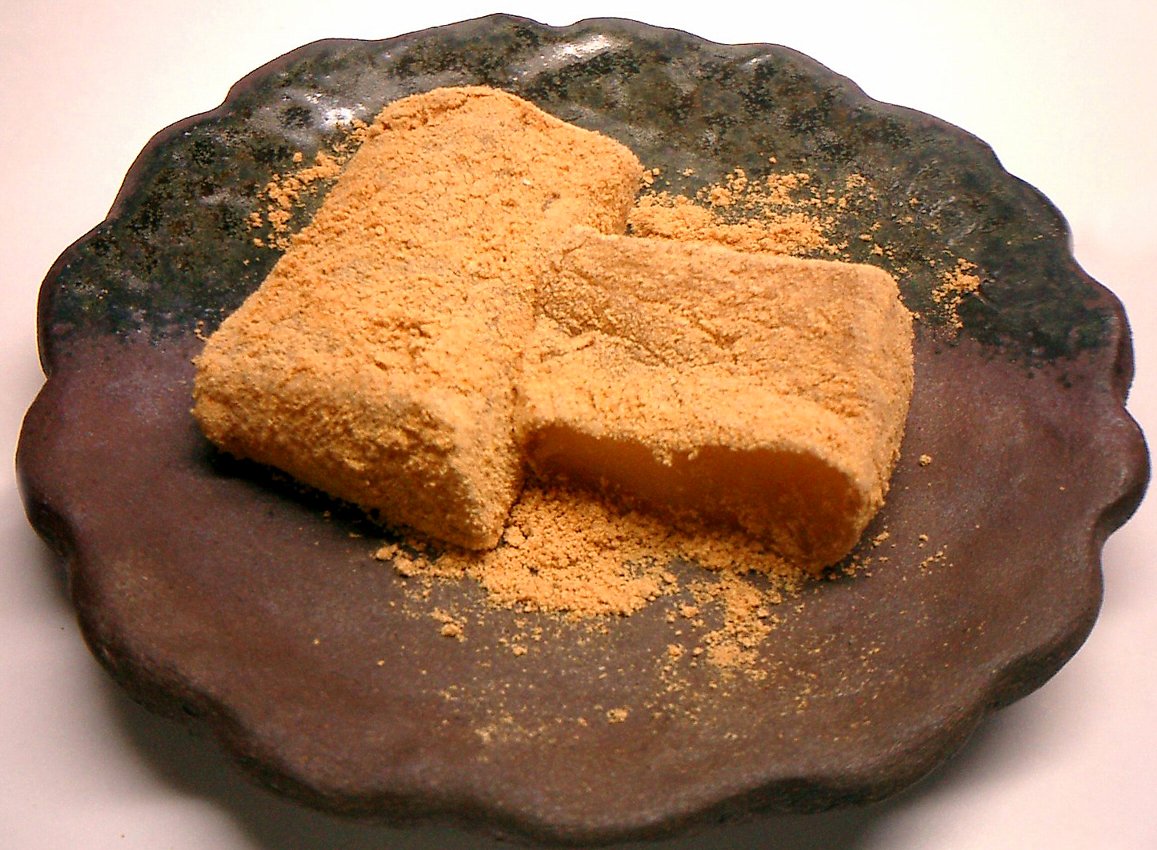|
Kuromitsu
is a Japanese sugar syrup. It is similar to molasses, but thinner and milder. It is typically made from unrefined (muscovado sugar), and is a central ingredient in many Japanese sweets. It is one of the ingredients used in making , and is eaten with , fruit, ice cream, and other confectionery. See also * List of syrups References Sources * Taste of Zen: kuromitsu recipe Japanese cuisine Syrup {{Japan-cuisine-stub ... [...More Info...] [...Related Items...] OR: [Wikipedia] [Google] [Baidu] |
Molasses
Molasses () is a viscous byproduct, principally obtained from the refining of sugarcane or sugar beet juice into sugar. Molasses varies in the amount of sugar, the method of extraction, and the age of the plant. Sugarcane molasses is usually used to sweeten and flavour foods. Molasses is a major constituent of fine commercial brown sugar. Molasses is rich in vitamins and minerals, including vitamin B6, iron, calcium, magnesium, and potassium. There are different types of molasses depending on the amount of time refined, including first molasses (highest sugar content), second molasses (slightly bitter), and blackstrap molasses (the darkest and most robust in flavor). Molasses was historically popular in the Americas before the 20th century as a sweetener. It is still commonly used in traditional cuisine, such as in Madeira Island's traditional dishes. In addition to culinary uses, molasses has industrial applications, such as in the distillation of rum, as an additiv ... [...More Info...] [...Related Items...] OR: [Wikipedia] [Google] [Baidu] |
List Of Syrups
This is a list of notable syrups. In cooking, a syrup is a condiment that is a thick, viscous liquid consisting primarily of a Solution (chemistry), solution of sugar in water, containing a large amount of dissolved sugars but showing little tendency to deposit crystals. Its consistency is similar to that of molasses. The viscosity arises from the hydrogen bonds between the dissolved sugar, which has many hydroxyl () groups, and the water. Syrups * Acetomel – a syrup made from honey and vinegar with a sweet and sour taste * Agave syrup – a Sugar substitute, sweetener commercially produced from several species of agave * Attar (syrup), Attar – a type of sweet syrup used in the preparation of Middle Eastern desserts * Barley malt syrup – an unrefined sweetener processed by extraction from Sprouting, sprouted, i.e., malted, barley, containing approximately 65 percent maltose, 30 percent complex carbohydrate, 3% protein * Birch syrup – a savory mineral-tasting syrup made ... [...More Info...] [...Related Items...] OR: [Wikipedia] [Google] [Baidu] |
Japanese Words And Phrases
Japanese may refer to: * Something from or related to Japan, an island country in East Asia * Japanese language, spoken mainly in Japan * Japanese people, the ethnic group that identifies with Japan through ancestry or culture ** Japanese diaspora, Japanese emigrants and their descendants around the world * Japanese citizens, nationals of Japan under Japanese nationality law ** Foreign-born Japanese, naturalized citizens of Japan * Japanese writing system, consisting of kanji and kana * Japanese cuisine, the food and food culture of Japan See also * List of Japanese people * * Japonica (other) * Japanese studies , sometimes known as Japanology in Europe, is a sub-field of area studies or East Asian studies involved in social sciences and humanities research on Japan. It incorporates fields such as the study of Japanese language, history, culture, litera ... {{disambiguation Language and nationality disambiguation pages ... [...More Info...] [...Related Items...] OR: [Wikipedia] [Google] [Baidu] |
Kuzumochi
is a Japanese language, Japanese term referring either to cakes made of (), starch derived from the root of the kudzu plant, or cakes made from Lactobacillales-fermentation in food processing, fermented wheat flour, wheat starch () which is speciality dish local to special wards of Tokyo, certain wards of Tokyo, served chilled and topped with and . The usual preparation consists in combining kudzu powder with water and sugar, and cooking it over a gentle heat, stirring continuously until the mixture thickens and becomes transparent. This process also imparts an elastic texture to the kuzu. The transparent appearance of the final product contributes to a cool sensation, making it a popular choice for consumption during warmer months. Gallery Kudzu starch cake,katori-city,japan.JPG, Tokyo-style 2010 Kuzumochi(Kudzu starch cake) by Sanda-Minoya.jpg Kuzumochi 001.jpg Funabashiya5.JPG External links Kuzumochi, a cool sweet summer dessert.May 30, 2008. Setsuko Yoshizuka, ... [...More Info...] [...Related Items...] OR: [Wikipedia] [Google] [Baidu] |
Kinako
''Kinako'' ( or "yellow flour") is roasted Soy flour, soybean flour, used in Japanese cuisine. In English, it is usually called "roasted soy flour". ''Kinako'' is mostly used as a topping to flavor rice cakes like mochi. History Usage of the word ''kinako'' appeared in Japanese cookbooks from the late Muromachi period (1336–1573). An early record of the word comes from the text ''Sōtan Chakai Kondate Nikki'' (''Sōtan's Tea Ceremony Cookery Menu Diary''), written in 1587 by Sen no Sōtan, a Japanese tea ceremony, tea ceremony master. Production ''Kinako'' is produced by finely grinding roasted soybeans into powder. The skin of the soybean is typically removed before pulverizing the beans, but some varieties of ''kinako'' retain the roasted skin. Yellow soybeans produce a yellow ''kinako'', and green soybeans produce a light-green product. Usage ''Kinako'' is widely used in Japanese cooking, but is strongly associated with ''dango'' and ''wagashi''. ''Dango'', dumplin ... [...More Info...] [...Related Items...] OR: [Wikipedia] [Google] [Baidu] |
Muscovado
Muscovado is a type of partially refined to unrefined sugar with a strong molasses content and flavour, and dark brown in colour. It is technically considered either a non-centrifugal cane sugar or a centrifuged, partially refined sugar according to the process used by the manufacturer. Muscovado contains higher levels of various minerals than processed white sugar. Its main uses are in food and confectionery, and the manufacturing of rum and other forms of alcohol. The largest producer and consumer of muscovado is India. Terminology The English name "muscovado" is derived from a corruption of Portuguese ' (unrefined sugar). The Indian English names for this type of sugar are ''khandsari'' and ''khand'' (sometimes spelled ''khaand''). There is no legal definition of muscovado, and no international standards for it such as ''Codex Alimentarius'' or ''Protected Designation of Origin''. This has led to manufacturers calling various sugar products "muscovado", and has led to conf ... [...More Info...] [...Related Items...] OR: [Wikipedia] [Google] [Baidu] |
Wagashi
is traditional Japanese confectionery, typically made using plant-based ingredients and with an emphasis on seasonality. ''Wagashi'' generally makes use of cooking methods that pre-date Western influence in Japan. It is often served with green tea. Most of today's wagashi was born during the Edo period (1603–1868). This was a period of peace, economic and cultural prosperity, and increased domestic self-sufficiency in sugar. During the Edo period, a type of wagashi called were made by kneading white bean paste, gyūhi, sugar, yams, and other ingredients, and formed into various colors and shapes based on seasonal flowers, animals, nature, events, customs, and other themes. Definition In Japan, the word for sweets or confectionery, , originally referred to fruits and nuts. Fruits and nuts may be eaten as snacks between meals and served as "sweets" during a tea ceremony. The word ''Wa'' means "Japanese", and ''kashi'' becomes ''gashi'' in compound words, ''wagashi'' there ... [...More Info...] [...Related Items...] OR: [Wikipedia] [Google] [Baidu] |
Kuzumochi
is a Japanese language, Japanese term referring either to cakes made of (), starch derived from the root of the kudzu plant, or cakes made from Lactobacillales-fermentation in food processing, fermented wheat flour, wheat starch () which is speciality dish local to special wards of Tokyo, certain wards of Tokyo, served chilled and topped with and . The usual preparation consists in combining kudzu powder with water and sugar, and cooking it over a gentle heat, stirring continuously until the mixture thickens and becomes transparent. This process also imparts an elastic texture to the kuzu. The transparent appearance of the final product contributes to a cool sensation, making it a popular choice for consumption during warmer months. Gallery Kudzu starch cake,katori-city,japan.JPG, Tokyo-style 2010 Kuzumochi(Kudzu starch cake) by Sanda-Minoya.jpg Kuzumochi 001.jpg Funabashiya5.JPG External links Kuzumochi, a cool sweet summer dessert.May 30, 2008. Setsuko Yoshizuka, ... [...More Info...] [...Related Items...] OR: [Wikipedia] [Google] [Baidu] |
Japanese Cuisine
Japanese cuisine encompasses the regional and traditional foods of Japan, which have developed through centuries of political, economic, and social changes. The traditional cuisine of Japan (Japanese language, Japanese: ) is based on rice with miso soup and other dishes with an emphasis on seasonal ingredients. Side dishes often consist of fish, Tsukemono, pickled vegetables, tamagoyaki, and vegetables cooked in broth. Common seafood is often grilled, but it is also sometimes served raw as sashimi or as sushi. Seafood and vegetables are also deep-fried in a light batter, as '. Apart from rice, a staple includes noodles, such as soba and udon. Japan also has many simmered dishes, such as fish products in broth called , or beef in and . Historically influenced by Chinese cuisine, Japanese cuisine has also opened up to influence from European cuisine, Western cuisines in the modern era. Dishes inspired by foreign food—in particular Chinese food—like ramen and , as well as foods ... [...More Info...] [...Related Items...] OR: [Wikipedia] [Google] [Baidu] |




